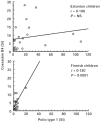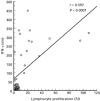Comparison of enterovirus-specific cellular immunity in two populations of young children vaccinated with inactivated or live poliovirus vaccines
- PMID: 10403922
- PMCID: PMC1905481
- DOI: 10.1046/j.1365-2249.1999.00954.x
Comparison of enterovirus-specific cellular immunity in two populations of young children vaccinated with inactivated or live poliovirus vaccines
Abstract
Enterovirus-specific cellular immunity was studied in Estonian and in Finnish children at the age of 9 months. The aim was to evaluate the level of responsiveness in two neighbouring countries with different poliovirus immunization practices and striking differences in the incidence of insulin-dependent diabetes mellitus (IDDM), a disease in which early enterovirus infections are an aetiological risk factor. The Estonian children immunized with live attenuated polio vaccine had stronger T cell responses to coxsackievirus B4 and poliovirus type 1 when compared with Finnish children immunized with inactivated polio vaccine (median stimulation indices 10.4 and 6.3 in Estonian children and 1.9 and 2.9 in Finnish children, respectively; P < 0.05). Lymphocytes stimulated by poliovirus type 1 antigen expressed interferon-gamma (IFN-gamma) mRNAs, which strongly correlated with the level of proliferation responses. Lymphocytes of Estonian children had a tendency towards stronger expression of IFN-gamma upon poliovirus challenge when compared with Finnish children. The number of children who had experienced coxsackievirus B infections, as determined by the presence of neutralizing antibodies, did not differ between Estonian and Finnish children. The results show that Finnish children have weaker cellular immunity against enteroviruses at the age of 9 months compared with Estonian children at the same age. This is most probably due to the difference in polio vaccination schedules; in Estonia live poliovirus vaccine is used and given at earlier ages than the inactivated vaccines in Finland. This leads to stronger T cell immunity which cross-reacts with other enterovirus serotypes. This may explain the lower incidence of IDDM in Estonia by providing effective protection against diabetogenic enterovirus strains in Estonian children.
Figures



Similar articles
-
Induction of interferon-gamma and IL-4 production by mitogen and specific antigens in peripheral blood lymphocytes of Type 1 diabetes patients.Autoimmunity. 2001;34(1):1-8. doi: 10.3109/08916930108994120. Autoimmunity. 2001. PMID: 11681488
-
Relation between T-cell responses to glutamate decarboxylase and coxsackievirus B4 in patients with insulin-dependent diabetes mellitus.J Clin Virol. 1999 Oct;14(2):95-105. doi: 10.1016/s1386-6532(99)00050-5. J Clin Virol. 1999. PMID: 10588452 Clinical Trial.
-
Surveillance of immunity acquired from poliovirus immunization including vaccination with the Sabin strain-derived inactivated vaccine.Hum Vaccin Immunother. 2019;15(5):1154-1159. doi: 10.1080/21645515.2019.1572408. Epub 2019 Mar 11. Hum Vaccin Immunother. 2019. PMID: 30676843 Free PMC article.
-
[The immunological basis of the administration of DTP-polio vaccine].Verh K Acad Geneeskd Belg. 2000;62(4):245-67. Verh K Acad Geneeskd Belg. 2000. PMID: 11004905 Review. Dutch.
-
Feasible improvements in vaccines in the Expanded Programme on Immunization.Rev Infect Dis. 1989 May-Jun;11 Suppl 3:S530-7. doi: 10.1093/clinids/11.supplement_3.s530. Rev Infect Dis. 1989. PMID: 2669097 Review.
Cited by
-
Diagnostic potential of parechovirus capsid proteins.J Clin Microbiol. 2003 Jun;41(6):2294-9. doi: 10.1128/JCM.41.6.2294-2299.2003. J Clin Microbiol. 2003. PMID: 12791839 Free PMC article.
-
A systematic approach to virus-virus interactions.Virus Res. 2010 Apr;149(1):1-9. doi: 10.1016/j.virusres.2010.01.002. Epub 2010 Jan 20. Virus Res. 2010. PMID: 20093154 Free PMC article. Review.
-
Enterovirus and type 1 diabetes: What is the matter?World J Diabetes. 2015 Jun 25;6(6):828-39. doi: 10.4239/wjd.v6.i6.828. World J Diabetes. 2015. PMID: 26131324 Free PMC article. Review.
-
Enteroviruses, type 1 diabetes and hygiene: a complex relationship.Rev Med Virol. 2010 Mar;20(2):106-16. doi: 10.1002/rmv.639. Rev Med Virol. 2010. PMID: 20049905 Free PMC article. Review.
-
Viral interference induced by live attenuated virus vaccine (OPV) can prevent otitis media.Vaccine. 2011 Nov 3;29(47):8615-8. doi: 10.1016/j.vaccine.2011.09.015. Epub 2011 Sep 20. Vaccine. 2011. PMID: 21939720 Free PMC article.
References
-
- Melnick JL. Enteroviruses: Polioviruses, coxsackieviruses, echoviruses and newer enteroviruses. In: Fields BM, Knipe DM, Howley PM, editors. Fields virology. 3. Philadelphia: Lippincott-Raven; 1995. pp. 655–713.
-
- Abzug MJ, Levin MJ, Rotbart HA. Profile of enterovirus disease in the first two weeks of life. Ped Inf Dis J. 1993;12:820–4. - PubMed
-
- Alexander JP, Chapman LE, Pallanch MA, et al. Coxsackievirus B2 infection and aseptis meningitis: a focal outbreak among members of a high school football team. J Infect Dis. 1993;167:1201–5. - PubMed
-
- Juhela S, Hyöty H, Lönnrot M, et al. Enterovirus infections and enterovirus specific T-cell responses in infancy. J Med Virol. 1998;54:226–32. - PubMed
Publication types
MeSH terms
Substances
LinkOut - more resources
Full Text Sources

